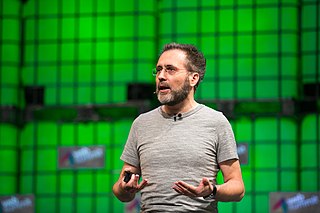Related Research Articles

The Defense Advanced Research Projects Agency (DARPA) is a research and development agency of the United States Department of Defense responsible for the development of emerging technologies for use by the military.
Grid computing is the use of widely distributed computer resources to reach a common goal. A computing grid can be thought of as a distributed system with non-interactive workloads that involve many files. Grid computing is distinguished from conventional high-performance computing systems such as cluster computing in that grid computers have each node set to perform a different task/application. Grid computers also tend to be more heterogeneous and geographically dispersed than cluster computers. Although a single grid can be dedicated to a particular application, commonly a grid is used for a variety of purposes. Grids are often constructed with general-purpose grid middleware software libraries. Grid sizes can be quite large.

The Internet Assigned Numbers Authority (IANA) is a standards organization that oversees global IP address allocation, autonomous system number allocation, root zone management in the Domain Name System (DNS), media types, and other Internet Protocol–related symbols and Internet numbers.

Internet2 is a not-for-profit United States computer networking consortium led by members from the research and education communities, industry, and government. The Internet2 consortium administrative headquarters are located in Ann Arbor, Michigan, with offices in Washington, D.C., and Emeryville, California.
The Berkman Klein Center for Internet & Society is a research center at Harvard University that focuses on the study of cyberspace. Founded at Harvard Law School, the center traditionally focused on internet-related legal issues. On May 15, 2008, the center was elevated to an interfaculty initiative of Harvard University as a whole. It is named after the Berkman family. On July 5, 2016, the center added "Klein" to its name following a gift of $15 million from Michael R. Klein.
The next-generation network (NGN) is a body of key architectural changes in telecommunication core and access networks. The general idea behind the NGN is that one network transports all information and services by encapsulating these into IP packets, similar to those used on the Internet. NGNs are commonly built around the Internet Protocol, and therefore the term all IP is also sometimes used to describe the transformation of formerly telephone-centric networks toward NGN.
United States federal research funders use the term cyberinfrastructure to describe research environments that support advanced data acquisition, data storage, data management, data integration, data mining, data visualization and other computing and information processing services distributed over the Internet beyond the scope of a single institution. In scientific usage, cyberinfrastructure is a technological and sociological solution to the problem of efficiently connecting laboratories, data, computers, and people with the goal of enabling derivation of novel scientific theories and knowledge.
The China Education and Research Network is the first nationwide education and research computer network in China. The CERNET project is funded by the Chinese government and directly managed by the Chinese Ministry of Education. It is constructed and operated by Tsinghua University and the other leading Chinese universities.
Neuroinformatics is the field that combines informatics and neuroscience. Neuroinformatics is related with neuroscience data and information processing by artificial neural networks. There are three main directions where neuroinformatics has to be applied:

Urs Hölzle is a Swiss software engineer and technology executive. He is the senior vice president of technical infrastructure and Google Fellow at Google. As Google's eighth employee and its first VP of Engineering, he has shaped much of Google's development processes and infrastructure.

The Energy Sciences Network (ESnet) is a high-speed computer network serving United States Department of Energy (DOE) scientists and their collaborators worldwide. It is managed by staff at the Lawrence Berkeley National Laboratory.
Digital Earth is the name given to a concept by former US vice president Al Gore in 1998, describing a virtual representation of the Earth that is georeferenced and connected to the world's digital knowledge archives.

The Edison Electric Institute (EEI) is an association that represents all U.S. investor-owned electric companies.

Al Gore is a former US Senator who served as the Vice President of the United States from 1993 to 2001. In the 1980s and 1990s, he promoted legislation that funded an expansion of the ARPANET, allowing greater public access, and helping to develop the Internet.

A smart grid is an electrical grid which includes a variety of operation and energy measures including:
Wu Jianping, also known as Jian-Ping Wu, is a Chinese computer scientist. He is Professor and Chair of Computer Science and Technology at Tsinghua University. He is also Chairman of the China Education and Research Network (CERNET) Technical Board and director of the CERNET center, and vice president of the China Internet Association.
The Netherlands Bioinformatics Centre or NBIC (2003-2013) was a Dutch, government-funded organization, that coordinated all academic work on bioinformatics in the Netherlands. NBIC consisted of programs for research (BioRange), for education (BioWise), and for support (BioAssist). NBIC partners are all Dutch universities and university hospitals, and some commercial entities. The NBIC central office was hosted by the Center for Molecular and Biomolecular Informatics (CMBI) at the Radboud University Nijmegen Medical Centre.
Edward W. Knightly is an American professor and the department chair of Electrical and Computer Engineering at Rice University in Houston, Texas. He joined the Rice University faculty in 1996. He heads the Rice Networks Group.

Farnam Jahanian is an Iranian-American computer scientist, entrepreneur, and higher education leader. He serves as the 10th president of Carnegie Mellon University.

ASPIDER is the group name for a series of companies that are mostly based in Europe. The company name has evolved over the years as a result of acquisitions, mergers and restructuring. The company is an MVNE, providing mobile services to companies that want to control their own network. Clients include enterprises, manufacturers, integrators, and the mobile operators themselves.
References
- ↑ "Next Generation Internet (NGI) Initiative Home Page". 1997-12-10. Archived from the original on 1997-12-10. Retrieved 2018-08-09.
- ↑ "About the NGI". 2005-09-16. Archived from the original on 2005-09-16. Retrieved 2018-08-09.